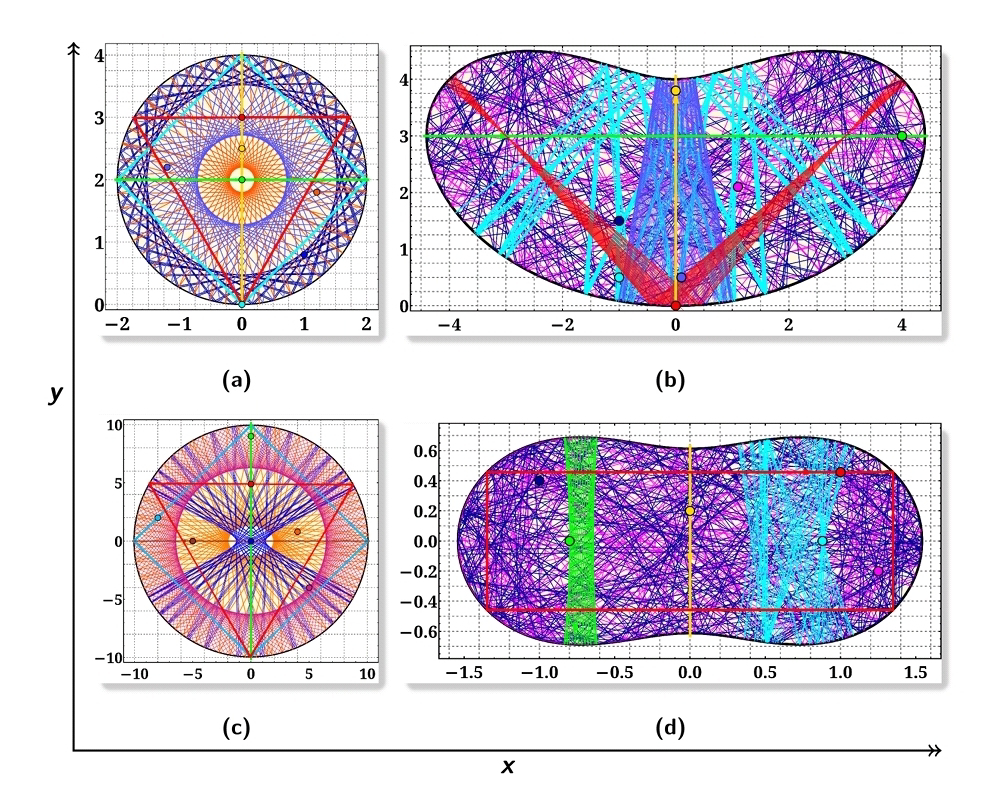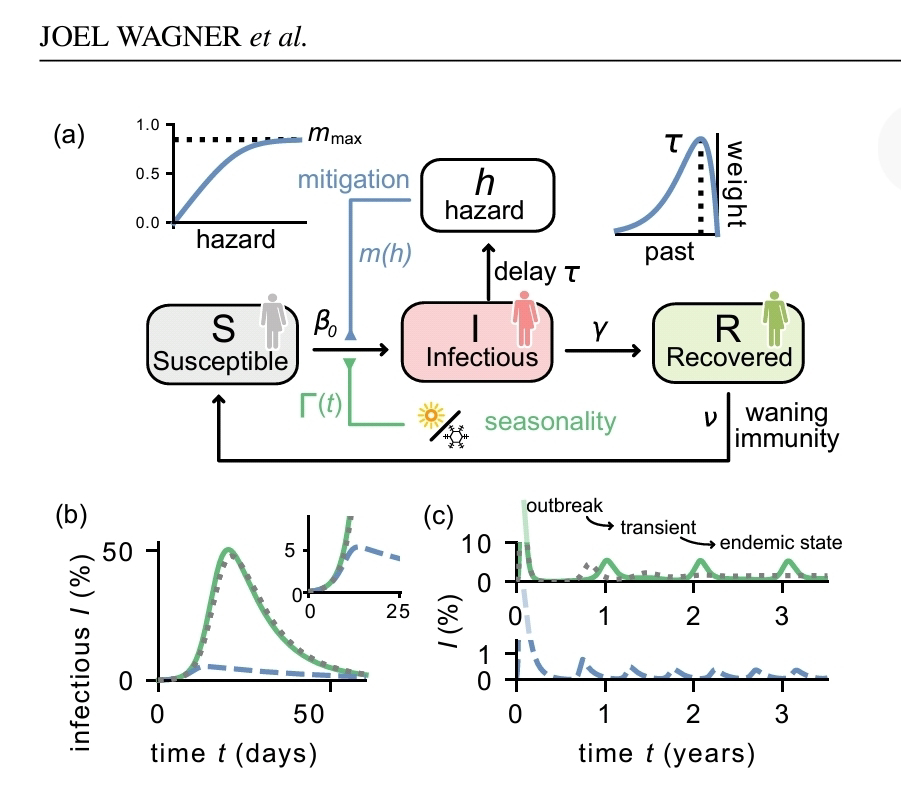Translate
mercoledì 12 febbraio 2025
# gst: chaotic billiards inside mixed curvatures
martedì 1 aprile 2025
# epidem: societal self-regulation appears to induce complex infection dynamics and chaos.
lunedì 14 ottobre 2019
# gst: chaotic dynamics modulate complex systems, even in the presence of extrinsic and intrinsic noise
AA << find that chaotic dynamics modulates gene expression and up-regulates certain families of low-affinity genes, even in the presence of extrinsic and intrinsic noise. Furthermore, this leads to an increase in the production of protein complexes and the efficiency of their assembly. Finally, (AA) show how chaotic dynamics creates a heterogeneous population of cell states, and describe how this can be beneficial in multi-toxic environments. >>
Mathias L. Heltberg, Sandeep Krishna, Mogens H. Jensen. On chaotic dynamics in transcription factors and the associated effects in differential gene regulation. Nature Comm. volume 10, Article number: 71 Jan 8, 2019. https://www.nature.com/articles/s41467-018-07932-1
<< Chaos in bodily regulation can optimize our immune system according to a recent discovery made by researchers at the University of Copenhagen's Niels Bohr Institute. The discovery may prove to be of great significance for avoiding serious diseases such as cancer and diabetes. >>
Chaos in the body tunes up your immune system. Niels Bohr Institute.
Jan 16, 2019. https://m.medicalxpress.com/news/2019-01-chaos-body-tunes-immune.html
Also
'l'immaginifico "tracciante ... che svagola nella macina ...' in: 2149 - onda di predazione (to knock seals off the ice). Notes. Dec 17, 2007. https://inkpi.blogspot.com/2007/12/2149-onda-di-predazione-to-knock-seals.html
Also
never boring with chaos and tit-for-tat theories. F.on.T. Jun 12, 2016. https://flashontrack.blogspot.com/2016/06/s-gst-never-boring-with-chaos-and-tit.html
lunedì 3 febbraio 2025
# gst: limit cycles and chaos in planar hybrid systems.
lunedì 3 settembre 2018
# gst: a chaos-inducing approach against superbugs evolution
<< The CHAOS [Controlled Hindrance of Adaptation of OrganismS] method takes advantage of this effect, pulling multiple genetic levers in order to build up stress on the bacterial cell and eventually trigger a cascading failure, leaving the bug more vulnerable to current treatments. The technique does not alter the bug's DNA itself, only the expression of individual genes, similar to the way a coded message is rendered useless without the proper decryption. >>
<< We now have a way to cut off the evolutionary pathways of some of the nastiest bugs and potentially prevent future bugs from emerging at all, >> Peter Otoupal
Chaos-inducing genetic approach stymies antibiotic-resistant superbugs. University of Colorado at Boulder. Sept 3, 2018.
https://m.phys.org/news/2018-09-chaos-inducing-genetic-approach-stymies-antibiotic-resistant.html
<< While individual perturbations improved fitness during antibiotic exposure, multiplexed perturbations caused large fitness loss in a significant epistatic fashion. >>
Peter B. Otoupal, William T. Cordell, et al. Multiplexed deactivated CRISPR-Cas9 gene expression perturbations deter bacterial adaptation by inducing negative epistasis. Comm Biol 1 (129) Sept 3, 2018
martedì 21 giugno 2022
# gst: even tight-binding billiards could exhibit chaotic behaviors
giovedì 20 giugno 2024
# gst: elasticity of fibres prefers the chaos of turbulence.
venerdì 18 ottobre 2024
# gst: isles of regularity (depending on the initial setup) in a sea of chaos amid the gravitational three-body problem.
venerdì 18 luglio 2025
# gst: self-feedback delay induces extreme events in the theoretical Brusselator system.
sabato 22 febbraio 2025
# gst: order and chaos in systems of coaxial vortex pairs
lunedì 27 dicembre 2021
# gst: reshaping Kuramoto model, when a collective dynamics becomes chaotic, with a surprisingly weak coupling.
lunedì 31 marzo 2025
# gst: synchronization and chaos in complex systems with delayed interactions.
giovedì 12 giugno 2025
# gst: unstable fixed points in chaotic networks
sabato 17 agosto 2024
# gst: networks of pendula with diffusive interactions, chaotic regime seems to emerge at low energies.
sabato 13 aprile 2024
# gst: evolving disorder and chaos induces acceleration of elastic waves.
mercoledì 14 maggio 2025
# gst: elasticity of fibers prefers the chaos of turbulence.
lunedì 9 aprile 2018
# brain: actually there is chaos in the brain
<< Besides some empirical findings of chaos at different time scales, the focus is on theoretical modeling of change processes explaining and simulating chaotic dynamics. It will be illustrated how some common factors of psychotherapeutic change and psychological hypotheses on motivation, emotion regulation, and information processing of the client's functioning can be integrated into a comprehensive nonlinear model of human change processes >>
Schiepek GK, Viol K, et al. Psychotherapy Is Chaotic - (Not Only) in a Computational World. Front Psychol. 2017 Apr 24;8:379. doi: 10.3389/fpsyg.2017.00379. eCollection 2017.
https://www.ncbi.nlm.nih.gov/m/pubmed/28484401/
<< Cambridge-based researchers provide new evidence that the human brain lives "on the edge of chaos", at a critical transition point between randomness and order. The study provides experimental data on an idea previously fraught with theoretical speculation >>
Public Library of Science. The Human Brain Is On The Edge Of Chaos. Mar 23, 2009.
https://www.sciencedaily.com/releases/2009/03/090319224532.htm
Manfred G. Kitzbichler, Marie L. Smith, et al. Broadband Criticality of Human Brain Network Synchronization. PLoS Comput Biol 2009; 5 (3): e1000314. doi: 10.1371/journal.pcbi.1000314. Mar 20, 2009.
http://journals.plos.org/ploscompbiol/article?id=10.1371/journal.pcbi.1000314
sabato 14 gennaio 2023
# gst: approaching chaotic dynamics to trace the complexity of rough nanostructured surfaces
martedì 20 novembre 2018
# gst: chaos from a double pendulum
<< Three double pendulums, all starting with near identical initial conditions, all rapidly diverging. >>
Ari Rubinsztejn. Chaos and the Double Pendulum. Nov 19, 2018.
https://gereshes.com/2018/11/19/chaos-and-the-double-pendulum









